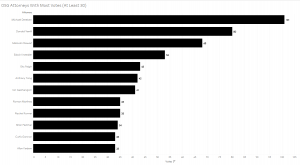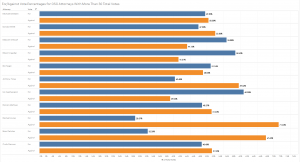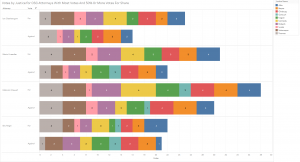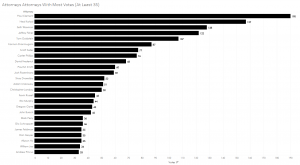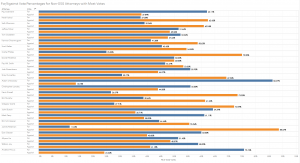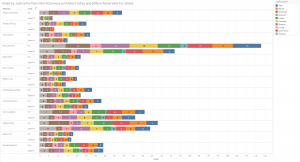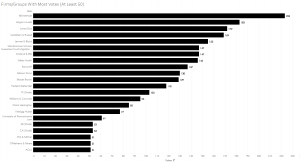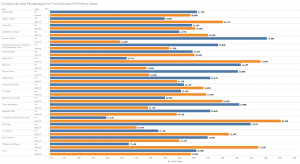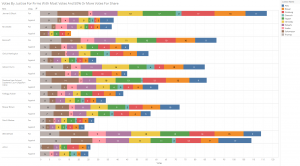Empirical SCOTUS: Advocates who drive the justices’ votes

on Apr 22, 2019 at 2:59 pm

Scholars of the Supreme Court often debate the role of lawyers in Supreme Court decision-making. For an attitudinalist, the justices’ preferences make all (or at least most of) the difference. According to this theory, justices will often vote based on their preferred policy direction, which minimizes the role of advocacy. More recent studies show that such a view, however, might obscure the impact lawyers have on Supreme Court output. Surprisingly, these two views are not necessarily mutually exclusive. Attorneys may also signal particular positions to the justices. If certain repeat Supreme Court attorneys take similar positions before the justices over time, the justices might presuppose such associations in advance of reading an advocate’s argument in the form of a brief.
This isn’t merely speculation. The federal government, for example, tends to take predictable positions in cases it argues before the Supreme Court. With this in mind, one study showed that attorneys from the Office of the Solicitor General signal their positions to the justices, and justices who are more partial to the government’s agenda are more likely to support OSG’s positions in given cases.
Although government attorneys are expected to advocate certain policy positions, nongovernment attorneys have more leeway in the positions they take. They may come back to similar positions in cases time and again, however. Among other things, this could be because of constraints at the firm level, their own selection decisions, or repeat clients’ requests.
In a 2015 study, Professors Adam Bonica, Adam Chilton and Maya Sen constructed a data-backed account of how attorneys’ preferences matter as well. An even stronger argument could be made for attorneys’ signaling effects if top Supreme Court attorneys not only hold specific policy preferences, but also tend to argue certain positions that align with these views. Of course, attorneys do not have unlimited agency in case before the Supreme Court, as many of the legal issues are generally resolved by the time a case gets to the court, and justices aren’t likely to vote for weak legal positions even if those positions accord with the justices’ policy preferences.
How can we discern whether particular justices are more or less partial to certain attorneys’ or firms’ positions in the aggregate? A cut at this involves matching justices’ votes with these attorneys and firms over a series of years. A previous Empirical SCOTUS post examined the most successful attorneys between the 2013 and 2017 Supreme Court terms. This post links that data with justices’ vote data from the Supreme Court Database to assess justices’ voting relationships with specific attorneys.
Because the Supreme Court takes only a small percentage of the thousands of cases petitioned to it each year, only a select few attorneys ever have a chance to argue cases before the court. The ability to break into Supreme Court practice is made even more difficult by the group of elite attorneys with multiple Supreme Court oral arguments. In this April 2019 oral argument sitting, for instance, about half of the arguing attorneys are first-timers before the Supreme Court, nine attorneys have 20 or more Supreme Court oral arguments in their career, and one attorney is arguing in two different cases. This disparity may play a role in the justices’ comprehension of repeat attorneys and their traditional positions on various issues.
OSG attorneys
These relationships between the justices and attorneys are apparent at the governmental level when looking at justices’ votes between the 2013 and 2017 Supreme Court terms. The following graph shows OSG attorneys with at least 30 total votes from the justices for these terms.
Career Department of Justice litigators Michael Dreeben, Malcolm Stewart and Edwin Kneedler compose three of the four attorneys who received the most votes. Former Solicitor General Donald Verrilli received the second most votes after Dreeben.
By matching the cases these attorneys argued with the justices’ votes from the Supreme Court Database, we get a look at how successfully the attorneys fared. The following graph shows whether the balance of the justices’ votes in cases argued by these government attorneys was for or against the positions argued by these attorneys.
The justices voted more frequently against several of the attorneys with the most overall votes, including Dreeben and Verrilli, than they voted for these attorneys. The most successful attorneys based on these cumulative voting percentages were Ian Gershengorn, another former solicitor general, and previously mentioned Edwin Kneedler.
The next graph focuses on the attorneys with at least 50 percent “votes for” in the previous graph (a 50 percent vote-for share or more) and looks at their relative support from individual justices. The attorneys are organized based on their relative vote-for share, from greatest to least.
Only four of the 11 government attorneys in the earlier graphs had vote-for shares of 50 percent or more. The justices’ votes were more polarized for some of these attorneys than others. Ian Gershengorn, who received the highest positive vote share, with almost 61 percent, received balanced votes from most justices. Justices Clarence Thomas and Stephen Breyer were the only justices to vote against him more often than they voted for him. Justices Sonia Sotomayor and Anthony Kennedy were the most supportive of Gershengorn’s positions, with Sotomayor voting in his favor in all four instances in which she voted and Kennedy voting in his favor in four of the five cases Gershengorn argued before him. Kneedler similarly performed well across justices, with no justices voting against his positions more frequently than they voted for his positions aside from Justice Neil Gorsuch. Stewart saw the greatest positive vote differential from conservatives Chief Justice John Roberts and Kennedy. Eric Feigin received more support from conservatives, Justice Samuel Alito and Thomas, than he did from liberals, Justices Elena Kagan, Ruth Bader Ginsburg, Sotomayor and Breyer.
Non-OSG attorneys
Repeat Supreme Court attorneys tend to have a good sense of what makes a winning argument before certain justices. However, they need to find ways to cobble together arguments supported by at least five justices, and the ability to do that varies by case and by position. Savvy veterans know or learn how to do this with regularity, but also can distinguish a winning argument from a losing one. Sometimes a repeat player’s job will be to push a certain position on an issue before the justices so that even if the attorney knows that an argument will ultimately fail, at least certain justices will be likely to focus on that argument in a dissent.
Two things that are potentially in an attorney’s control are whether to accept a case and how to argue a position. Attorneys may lose justices’ votes at either level and this is a necessary takeaway from looking at attorneys’ success across justices’ votes. Attorneys who win a high percentage of justices’ votes may take positions that are easier to win or may make more compelling arguments. There is little ability to distinguish between the two when observing at the vote level. When attorneys are successful with such regularity that they garner a high percentage of votes in more than two or three decisions, however, this shows an ability to forecast the court in a unique manner.
The graphs looking at attorneys start by isolating the attorneys with at least 35 votes across justices between 2013 and 2017. Twenty-five attorneys fit within this parameter.
The names at the top of this list include some of the most prolific Supreme Court attorneys in the history of the court. The top three attorneys in terms of total votes for this period – Paul Clement, Neal Katyal and Seth Waxman – each served as the U.S. solicitor general. The next several attorneys on this list vary in their type of practice, from Supreme Court clinic attorney (Stanford’s) Jeffrey Fisher, to private big-law appellate practice attorney Kannon Shanmugam, to boutique-law appellate practice attorney Tom Goldstein, to state-government representative Scott Keller, who is now back in private practice.
Many repeat attorneys did not string together votes at the Supreme Court. This may be due to the fact that more complex cases have outcomes that are hard to predict. Attorneys might end up with a lower average favorable vote from the justices based on several close cases with one or two unanimous losses, just as attorneys may end up with higher averages through one or more unanimous victories. Attorneys’ percentages of favorable votes across justices are shown in the following graph.
The attorney with the highest overall vote-for share was Adam Unikowsky at 86.27 percent. That is over 10 percent higher than the next most successful attorney across justices, Andrew Pincus, at 75.76 percent. Pincus is also more than 10 percent higher than the third most successful attorney, John Bursch, at 64.29 percent.
Thirteen, or just over half of these 25 top Supreme Court attorneys, averaged at least 50 percent favorable votes from the justices across their cases. The next graph shows votes for and against these attorneys’ positions by justice.
As with the previous graph showing votes by justice, the above graph is organized in order of attorneys with the highest overall vote-for share across the justices. Unikowsky, with the highest overall percentage, did well across all justices, with more votes in his favor (and generally several more) from all justices except Gorsuch. Ginsburg, Kagan and Roberts voted for Unikowsky’s positions on all six occasions when he argued.
Pincus too did well across justices, with all justices voting for his positions more frequently or as frequently as they did against his positions. Alito and Kennedy supported Pincus’ positions in all four of his argued cases. Bursch had more success with some justices, including Kennedy, Roberts and Breyer, who each voted for his positions in four of his five arguments, than he had with others, including Sotomayor and Ginsburg, who voted against his positions in more cases than they voted for them. Clement, who argued many more cases than other attorneys on this list, had more votes supporting his positions than against them from each justice.
Some of the attorneys split the justices’ votes more ideologically. Jeffrey Fisher, for instance, received 11 votes in support and three votes against from Sotomayor and 10 votes in support and four votes against from Kagan on the left, while he received five votes in support and nine votes against from Thomas and four votes in support and 10 votes against from Roberts on the right.
Groups and firms
The most active firms for this period were often a product of multiple attorneys’ efforts, with generally one veteran advocate taking the majority of argument opportunities for the firm. The graph below shows firms with at least 50 votes from the justices for the 2013 through 2017 terms.
WilmerHale had by far the most justice votes with 223. Seth Waxman argued the majority of these cases but had support from Mark Fleming, Danielle Spinelli and Thomas Saunders, among others. Hogan Lovells received the second most overall votes, with Neal Katyal arguing the majority of the cases, although other cases were argued by Catherine Stetson, Frederick Liu and Dominic Perella.
The next graph tracks the justices’ support percentages for each of these firms.
Driven by Adam Unikowsky’s success in the court, Jenner and Block is the top-performing firm in terms of percentage of overall justices’ votes. Nine firms along with Jenner received at least a 50 percent vote-for share from the justices. These 10 firms are included in the next graph breaking down firms by justices’ votes.
Support from particular justices is evident with many of the firms on this list. This appears to be the case more than it was with the individual nongovernmental attorneys. Jenner and Block was able to pull together fairly strong support across justices, however, with Justice Antonin Scalia the only justice voting against the firm’s positions more often than he voted for them and Thomas voting an equal number of times for and against the firm’s positions. Michigan’s solicitor general’s office was able to pull strong support, especially from the court’s right wing. Thomas, Alito and Scalia each voted unanimously for the Michigan office in all six cases its attorneys argued before the court. Sotomayor and Kagan were more frequently opposed to the office’s positions than they were in support of them.
The next set of firms, Bancroft and Orrick Harrington, pulled support across justices, with all justices voting for their positions more frequently than they voted against them. Going a bit deeper into this list we see more ideological divisiveness from the justices. The Republican-nominated justices, Thomas, Scalia, Roberts, Kennedy, Gorsuch and Alito, all strongly supported Gibson Dunn’s positions, while Sotomayor and Ginsburg each voted against Gibson’s positions at least twice as frequently as they voted for them. On the other end of the ideological spectrum, liberal justices Sotomayor, Kagan, Ginsburg and Breyer, along with Kennedy, showed strong support for Stanford Law School’s Supreme Court Litigation Clinic’s positions, while all more conservative justices aside from Kennedy and Alito voted against the clinic’s positions more frequently than they voted for them.
This post was originally published at Empirical SCOTUS.



